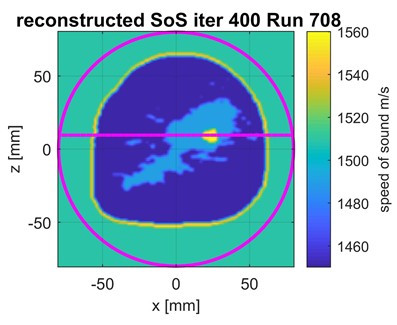
Highres
- contact:
- project group:
SWM - USCT
- funding:
DFG
- Partner:
Prof. Dr. Jürgen Hesser, Universität Heidelberg
- startdate:
2016
- enddate:
2020
Sound velocity and attenuation images of the breast imaged with 3D-USCT allow quantitative tissue characterization. In this project a wave-based reconstruction method based on paraxial approximation was developed, which increases the resolution of 3D transmission images by one order of magnitude.
Ultrasound computed tomography (USCT) is a novel imaging technique with high potential for improving breast cancer diagnosis. First clinical studies with USCT already show how important transmission tomography is to achieve high sensitivity and specificity: Sound velocity and attenuation, which are imaged in transmission tomography, should enable quantitative tissue characterization.
In this project the resolution of 3D transmission images shall be increased by one order of magnitude. At the same time it should be possible to calculate images on today's computers. For this purpose we developed a more accurate forward modelling with the paraxial approximation of the wave equation. The inverse problem was solved with novel numerical optimization methods, preconditioning methods and multigrid approaches to ensure fast and reliable convergence.
We developed and verified the basic methods for wave propagation in 3D with the paraxial approximation of the Helmholtz equation for arbitrary objects at a realistic size of the KIT 3D aperture. The forward model was implemented in MATLAB and ported to CUDA C for GPU acceleration, achieving an acceleration factor of about 20. In collaboration with TU Delft we developed a "redatuming" technique based on the Hankel decomposition of the measured field to backproject the measured pressure field from the sensors to the region of interest which is reconstructed.
For the inversion process we analyzed different approaches to reduce the computational effort: With Cholesky preconditioning the number of iterations could be reduced by about 70 to 85%. The matrix-free quasi-Newton preconditioning method saves on average about 30% of the computing time. In addition, we developed a multigrid scheme for the transition from low to high frequencies while adjusting the discretization of the mapped area of interest. We showed that the conjugate gradient applied to normal equation (CGNE) method provides more reliable solutions for linearized systems than the Tikhonov regularization methods. We showed that the L-BFGS algorithm can be used as a preconditioning technique for Gauss-Newton CG and nonlinear CG and was able to significantly accelerate nonlinear CG in particular, with up to 22.7 times reduction in the number of iterations and 21.4 times acceleration in computation time.
The methods were evaluated with several software phantoms using simulated data. The reconstructed values of sound velocity and attenuation correspond with very high accuracy to the values of the fundamental truth: a mean square error (MSE) of 3.4e-11 at the last iteration was achieved. We analyzed the convergence and robustness as a function of the starting frequency of the reconstruction. We were able to achieve a convergence at a start frequency of 1MHz, which corresponds to the lowest frequencies of the measurement data of the KIT-3D-USCT system.
In summary, we developed and analyzed a wave-based transmission image reconstruction for 3D-USCT at high frequencies and large FOV - an application that was not possible with previous methods. In contrast to full-wave solutions, paraxial approximation was applied, which is particularly suited to the forward problem because it takes into account the wave propagation in a preferred direction. We showed that the resolution of transmission images can be significantly improved compared to radiation-based algorithms. In contrast to full wave solutions, the computing time could be reduced considerably.
Technology: Ultrasound Computer Tomography

